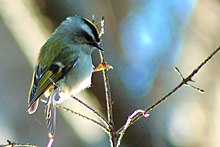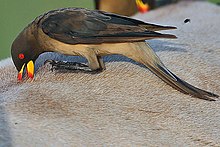Gleaning (birds)
Gleaning is a feeding strategy by birds in which they catch invertebrate prey, mainly arthropods, by plucking them from foliage or the ground, from crevices such as rock faces and under the eaves of houses, or even, as in the case of ticks and lice, from living animals. This behavior is contrasted with hawking insects from the air or chasing after moving insects such as ants. Gleaning, in birds, does not refer to foraging for seeds or fruit.
Gleaning is a common feeding strategy for some groups of birds, including
Techniques and adaptations

Foliage gleaning, the strategy of gleaning over the leaves and branches of trees and shrubs, can involve a variety of styles and maneuvers. Some birds, such as the common chiffchaff[1] of Eurasia and the Wilson's warbler[2] of North America, feed actively and appear energetic. Some will even hover in the air near a leaf or twig while gleaning from it; this behavior is called "hover-gleaning".[2] Other birds are more methodical in their approach to gleaning, even seeming lethargic as they perch upon and deliberately pick over foliage. This behavior is characteristic of the bay-breasted warbler[2] and many vireos.[3] Another tactic is to hang upside-down from the tips of branches to glean the undersides of leaves. Tits such as the familiar black-capped chickadee are often observed feeding in this manner. Some birds, like the ruby-crowned kinglet[3] and red-eyed vireo[4] of North America use a combination of these tactics.
Gleaning birds are typically small with compact bodies and have small, sharply pointed
Birds often specialize in a particular niche, such as a particular stratum of forest or type of vegetation. In


Further specialization within a habitat is associated with behaviors and morphological adaptations (physical traits of size and shape). Tiny birds are lightweight enough to hang onto the ends of twigs and pluck small prey; the
Crevice-gleaning is a niche particular to dry and rocky habitats. Adaptations for crevice-gleaning are similar to that of bark-gleaning. Just as the Bewick's wren, as mentioned in the preceding paragraph, has a long bill suited for poking around in the small places of woods and gardens, another North American wren, the canyon wren, has an even longer bill, which allows it to probe crevices in rocky cliffs. It also has skeletal adaptations to aid it in reaching deep into small spaces. These same traits are useful for gleaning the sides of buildings, as well.[3] Another kind of rocky habitat is found along mountain streams, where birds such as the Louisiana waterthrush[2] of North America and the forktails[5] of Asia pick over stream-side rocks and exposed roots for aquatic insects and other moisture-loving prey.
Other foraging techniques
Foraging for invertebrate prey on the ground often involves gleaning the
A feeding technique that is somewhere between gleaning and hawking is where a bird flies from a perch and takes prey off foliage; this is called "sally-gleaning". The pygmy tyrants of South America are tiny flycatchers that feed this way.[14] The todies of the Caribbean employ a distinct version of sally-gleaning. These small birds choose a perch within their lush forest and plantation habitats in the Greater Antilles, from which they scan the undersides of leaves above them. Upon spotting an insect or spider, they fly up in an arcing sally, pluck their prey item without stopping, and complete the arcing movement to land on a new perch.[9]

An unusual feeding strategy is that of the
There are other tactics.
Behavioral implications

Gleaning, like other methods of foraging, is a highly visual activity, and as such has some implications for birds. First, to see requires light, and thus time allotted to gleaning is limited to daytime. Second, while a bird focuses on examining an area for prey items, it must necessarily divert its attention from scanning its surroundings for predators. Birds that glean in tree branches will often join together in a flock, and often with other gleaners in a mixed-species foraging flock. It has been shown that individual birds feeding in flocks are able to spend more time looking for food and less time looking for predators.[17]
On the other hand, it is not a universal trait of gleaning birds to join with other species or even to be gregarious with their own kind. The
References
- ^ Peterson, Roger; Mountfort, Guy; Hollom, P.A.D. (1954). A Field Guide to the Birds of Britain and Europe. London: Collins. p. 251.
- ^ ISBN 0-395-78321-6.
- ^ a b c d e f g h
Barker, F. Keith; Clark, George A. Jr.; Grzybowski, Joseph A.; Humann, Alec; Jaramillo, Alvaro; Kricher, John; Reed, J. Michael; Sargent, Martha; Sargent, Robert (2001). National Audubon Society – The Sibley Guide to Bird Life & Behavior. Alfred A. Knopf. pp. 360–361, 377, 390, 404, 427, 435–436, 441, 451, 545.
- ^ Cimprich, David A.; Moore, Frank R.; Guilfoyle, Michael P. (2000). A. Poole (ed.). "Red-eyed Vireo (Vireo olivaceus)". The Birds of North America Online. Ithaca: Cornell Lab of Ornithology. Retrieved 5 April 2010.
- ^ a b c d e f
Myers, Susan (2009). Birds of Borneo. ISBN 978-0-691-14350-7.
- ISBN 0-00-711112-6.
- ^ a b
Schulenberg, Thomas S.; Stotz, Douglas F.; Lane, Daniel F.; O'Neill, John P.; Parker, Theodore P. III (2007). Birds of Peru. ISBN 978-0-691-13023-1.
- ^ a b c d e
Grimmett, Richard; Inskipp, Carol; Inskipp, Tim (1999). A guide to the birds of India, Pakistan, Nepal, Bangladesh, Bhutan, Sri Lanka, and the Maldives. ISBN 0-691-00687-3.
- ^ ISBN 0-691-02424-3.
- ^ Walters, Eric L.; Miller, Edward H.; Lowther, Peter E. (2002). "Red-breasted Sapsucker (Sphyrapicus ruber), The Birds of North America Online (A. Poole, Ed.)". Ithaca: Cornell Lab of Ornithology. Retrieved 26 September 2010.
- ^ Kennedy, E. Dale; White, Douglas W. (2000). "Bewick's Wren (Thryomanes bewickii), The Birds of North America Online (A. Poole, Ed.)". Ithaca: Cornell Lab of Ornithology. Retrieved 5 April 2010.
- ISBN 0-691-08529-3.
- ISBN 0-12-588971-2.
- ^
Schulenberg, Thomas S.; Stotz, Douglas F.; Lane, Daniel F.; O'Neill, John P.; Parker, Theodore A. III (2007). Birds of Peru. Princeton: Princeton University Press. p. 426. ISBN 978-0-691-13023-1.
- ISBN 0-7136-3961-X.
- ^ Peer, Brian D.; Bollinger, Eric K. (2000). "Common Grackle (Quiscalus quiscula), The Birds of North America Online (A. Poole, Ed.)". Ithaca: Cornell Lab of Ornithology. Retrieved 5 April 2010.
- ^ ISBN 978-0-7167-4983-7.
